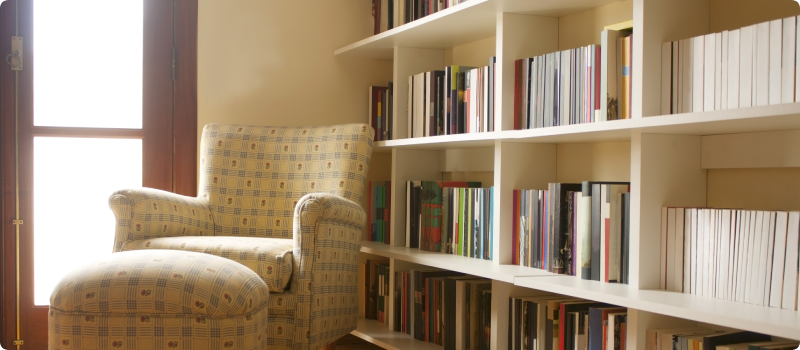DIY Tips on How to Make Your House Soundproof
Updated September 16, 2024 . AmFam Team
Whether you live in a house or an apartment, outside noise can turn from a minor problem into a major issue over time. But don’t get too worried just yet.
We’ve put together a whole list of noise-reducing ideas and DIY tips to help soundproof a room and stop noise in its tracks. And that can help bring a little more peace and quiet into your busy life. Be sure you run your noise-reduction plan by your landlord to verify they’re on board before you make any changes to your rental!
How Can I Make My House Soundproof?
By reducing sound with the right materials, you can decrease the noise level inside. But you’ll have to figure out how noise is getting in and then come up with a plan to keep it out. Here are some tips to sleuth out the sound source and suggestions to stop it:
How Does Sound Get Into Your Home?
When the windows and doors are closed tightly, and you’re still hearing outside sounds, it may be that noise is entering into your home another way.
Sound travels through air gaps and cracks. If you can see daylight through the bottom of your entry door or around the perimeter of a window, outdoor noise can easily get into your house. Mail slots are another culprit.
Audible sounds can transfer through walls. Exterior walls that have no insulation can transport noise.
Exterior vents can carry sound. Vents and ducting offer a direct channel for sound to move into your living space.
Uninsulated floors, walls and ceilings can deliver noise. The sounds your neighbors make around you can travel into your living space when no barrier or sound-blocking material is there to stop it.
Window-mounted AC units can transfer noise. Sound flows and transfers through the air gap between the top and bottom panes. Place foam in that area to insulate sound and keep cool air in your home.

How Can You Stop Sound From Entering Your House?
Reducing the amount of noise in your home can be tricky — there are many ways that sound can find its way in. Take a look at these ideas to help increase the peace in your place:
Install acoustic storm windows and doors. Although it’s a more expensive solution, acoustic storm windows and doors have proven to be very effective at preventing outside noise from entering your home.
Blow insulation into the walls. By pumping insulation into the cavities between the outside and the inside of your walls, you’ll be doing yourself two important favors. First, all that mass in the wall will help stop sound from entering your house. And second, you’re likely to find that your home is more energy efficient.
Replace windows that have cracked or broken glass. Even small crevices offer air a pathway to transfer noise. And air infiltration through broken windows can also lead to a leaky house, increasing your energy bills.
Place bookshelves against exterior walls. A thick barrier between a noise source and your living space can help to keep that unwanted sound out of your home.
Add another layer of drywall to exterior-facing walls. By simply placing another layer of drywall directly onto an existing wall, you can reduce the amount of interior noise.
Hang thick, sound-absorbing curtains over windows. This is a good answer if you’re finding noise levels are an issue in the evening. It’s a quick way to add privacy and serenity to your home.
Use white noise-making devices. If you’re looking to just dull the constant noise, try picking up acoustic blocking white noise machines. They’re commonly found in the waiting areas of therapy offices and spill out white noise that blocks the sound of the human voice.
Hang tapestries across exterior walls. Thick, decorative carpets can be used to help keep the noise down.
Close the flue on your fireplace. By caring for to your fireplace, you can help keep utility fees down. The temperature in your place will feel more consistent and you’ll also be reducing outside noise.
Seal the windows. Use acoustical caulk or putty around windows to help seal the sound out.
Block air from entering through the bottom of exterior doors. Install a rubber threshold or gasket to the bottom of every door that leads outside. Focus on preventing light from infiltrating and you’ll also keep sound out.
Upgrade to solid core doors. By upgrading from hollow core doors, you’ll find noise is reduced. For extra noise cancellation, consider swapping out interior doors.
Install acoustic panels strategically. Prevent noise from entering your room by placing sound-absorbing panels against walls where noise frequently finds its way in.
Install sound insulating ceiling tiles. Prevent sound from overtaking your living room with these self-adhesive soundproof barriers. They’re frequently used for sound blocking in offices and other professional settings.
Put on a pair of noise-cancelling headphones. When all else fails, remember you still have options. Look online for a good pair of Bluetooth-enabled headphones and relax to your favorite music.
And there you have it! Your home really can be an oasis of peace and serenity even with the roar of the outside noise only steps away. While you’re looking at ways to make your space more soundproof, remember to check in with your American Family Insurance agent to ensure you’re protecting what matters most.
This article is for informational purposes only and based on information that is widely available. We believe this information is accurate but do not make any guarantees or promise any results based on this information.
Tools & Resources
NextScripts
JSS component is missing React implementation. See the developer console for more information.

